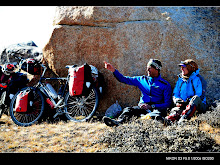About deserts, the great wall, Sleeping Buddha's and high mountains
These last weeks were the last that we cycled on the silk road. The variety of landscapes and weather conditions we've seen in the last four months, were all coming back in just these few weeks. The biggest part of the route was through the Gansu-corridor, the only way through for all the caravans on their trading route. From Dunhuang we entered the corridor through the Gobi-desert and we left it by crossing the high Qilian-mountains.
Dunguang is an oasis, famous for its Buddhist Mogao caves and the sand dunes with the Crescent Moon lake at the edge of town. After many months of moslim art and architecture we now gaze at ancient murals en 36 meters high Buddha statues. These caves were ordered to be made by wealthy merchants, to pray for a safe journey on the silk road or to thank for a safe return and good trade.
From Dunguang to Jiayuguan we cycle through the Gobi desert. There are many oasis and the weather is okay, making it bearible. The tougher the circumstances, the more compasionate people are. On a hot and dry day, we get bottles of water and big melons besides the many 'thumbs up' from car windows. We do worry when all of a sudden the skies turn black/ yellow and the wind strengthens. Everything looks like a sandstorm is coming our way! We've read that sometimes they can last for three days.. It's another 15 km to a village and with the strong wind in our back we paddle as fast as we can. Just a few minutes before we reach safety, the storm catches us.
There are two more silk road cities on our way; Jiayuguan and Zangye. The caravans used to long for Jiayuguan. This point marked the beginning of the civilised (chinese) world and all the big dangers were left behind. This is where the Great Wall starts with an impressive fort wich used to control the whole corridor. In Zangye we find the biggest sleeping Buddha of China in a beautiful temple. We also discover that Marco Polo used to live in Zangye for one year when we find his statue in the centre of town.
From Zhangye we change our direction since months; we're heading south! We have to cross the Qilian mountains. It looks like a big farm up here, everybody's working on the feelds using only hands, yaks or cows. They do stop their work to look at the passing bikers. The harvest lies neatly packed on the fields, on the trucks or on the back of donkeys. Not a piece of land is unused and even on the steep hills they build terraces with simple but genieus irrigation systems.
We pass Mati Si, a secred buddhist place where we stay for a day to soak up the autumn. Ahead of us lie the big mountains. We do not know how many passes we have to cross or how high they are. It turns out there are three very high and very cold passes (around 3700 mtr). The road is very good, ascending slowly so we can climb without any problems. In the morning weather is clear and the vieuw is breathtaking; snow on the high peaks but the sheep and yaks are still grazing at the grasslands. Most people are Tibetan or Hui (muslim) and they cheer us very warmly.
We are now in Xining, having a rest and visiting a tibetan monastry, Ta Er Si. About 700 monks live in this beautiful place with its special atmosphere.
After five months we will leave the silk roads, heading south in the direction of Sichuan and Yunnan provence. Many high mountains on the way and autumn chasing us....Our adventure continues!
P.S. For those of you who haven't discovered our photo's yet: in the right collum on our website you'll find the links to all our pictures (and statistics). You can also click on this one: http://picasaweb.google.com/maartenhovers (photo's) http://spreadsheets.google.com/pub?key=pz5aK4ejq4Ozr_N3gIfyGMQ (statistics)
Friday, October 17, 2008
Subscribe to:
Post Comments (Atom)


No comments:
Post a Comment